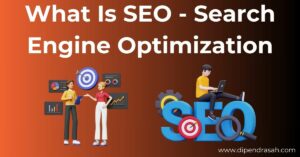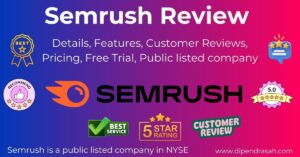SEO, or Search Engine Optimization, is pretty much your website’s secret sauce for showing up on search engines like Google. It’s the art and science of tailoring your online presence to meet the needs and preferences of people searching for relevant content. Think of it as aligning what you’re offering with what users are looking for.
Why does SEO matter? It’s simple: without it, even the most amazing content might stay hidden in the vast expanse that is the internet. You want your potential audience to find you easily, right? That’s where SEO steps in, ensuring that your website isn’t just another needle in the digital haystack but a top result in search engine listings.
Let’s chat real-world impact for a second. Imagine you’ve got an online store selling eco-friendly products. Through effective SEO, you optimize your site to connect with customers searching for sustainable living solutions. You focus on keywords your audience uses, you get seen more, traffic goes up, and suddenly, those sales figures look a whole lot happier. Just by understanding and implementing the basics of SEO, you’ve drastically improved your online visibility.
What makes SEO interesting is how it blends creative and technical skills. You’re balancing the art of writing content that people love with the technical know-how of structuring your site so search engines can understand it. This balance is key to making sure your website talks to real people while also getting those shiny search engine approval nods.
Keyword Research: The Foundation of SEO
Keywords are the words or phrases people type into search engines, and they’re at the heart of any successful SEO strategy. Picture this: you’re throwing a party and need to send out invitations. Without knowing who’s coming or what they like, you’re just guessing. Keywords are like those invitations, directly connecting you with your audience.
Understanding user intent behind keyword searches is key. It’s like stepping into your customer’s shoes and figuring out what they’re really looking for. Are they just browsing for information, or are they ready to purchase? Knowing this helps you tailor your content accordingly.
To do this right, you need the right tools. Think of options like Google Keyword Planner or SEMrush as your best mates, helping you explore the most relevant and potent keywords. With these tools, dive into search volumes and competition levels to gauge what’s worth focusing on.
You’ve probably heard of long-tail and short-tail keywords. Long-tails are those detailed, often three or more word phrases that reflect specific search intents – less competition, but more precise audiences. Short-tails are broad, bringing in lots of visitors, though maybe not always the right ones. A balanced mix is smart and helps meet different user needs.
The takeaway? Keyword research lays the groundwork for building content that not only appeals to search engines but genuinely listens and responds to what folks are searching for. This is what transforms casual visitors into engaged users.
On-Page SEO: Crafting Content That Resonates
On-page SEO is all about making sure your website speaks the language of both people and search engines. It’s your chance to shine, showing what your content is about and why it’s valuable.
Let’s talk content optimization. This means creating clear, engaging, and relevant content that offers real value to readers. It’s not just about loading your page with keywords but making sure those keywords flow naturally, almost like they were always meant to be there.
Meta titles and descriptions are your first impression in search results. A well-crafted title and description not only help search engines index your content but also invite users to click and explore your site. It’s like the perfect teaser that gets you curious enough to want more.
Internal linking strategies are another smart move. By linking relevant content within your site, you guide readers to more of your great material, keeping them around longer. Plus, it helps search engines understand your site structure and content relationships.
Using headers (H1, H2, H3) correctly helps break down information, making it easier for both users and search engines to digest what you’re trying to say. Each header should give clear hints about the section’s content so visitors can scan through with ease.
When you get on-page SEO right, you enhance the overall user experience and increase the chances of ranking well in search results. It’s a win-win because visitors get valuable content, and you gain credibility with search engines.
Off-Page SEO: Building Credibility
Off-page SEO is like the social butterfly of your SEO strategy. It’s about how others perceive and interact with your content beyond your website’s borders, and it plays a crucial role in building your site’s authority.
Backlinks are at the core of off-page SEO. These are like votes of confidence from other websites, signaling that your content is worth checking out. But remember, quality matters way more than quantity. A link from a well-respected site can boost your authority way more than a hundred links from obscure sources.
Social signals are also significant players. While they aren’t direct ranking factors, they showcase your content’s influence and popularity. When people share, like, or comment on your posts, it indicates that you’ve hit the right chord, which can ripple into improved search visibility.
For those looking to amplify reach, collaborating with influencers can give you an edge. Influencers already have a loyal audience that trusts their judgement. Partnering with them can introduce your brand to new potential followers who are likely to be interested in what you offer.
It’s essential to create content people want to engage with and share, forming organic connections across various platforms. This authentic interaction outside your bubble fortifies your online presence and establishes long-term credibility. Off-page SEO is about creating genuine relationships that propel your site’s authority in the vast online community.
Technical SEO: Enhancing Website Performance
Technical SEO focuses on the nuts and bolts of your site, ensuring search engines can crawl and index your content effectively. While it might seem like a background player, it’s critical for making your site user-friendly and accessible.
Mobile-friendliness is a significant aspect of technical SEO. With the majority of users browsing on phones or tablets, ensuring that your website is responsive and easy to navigate on smaller screens is vital. A mobile-friendly site not only satisfies users but also aligns with search engines’ preferences.
Site speed optimization is another crucial factor. Nobody likes waiting forever for a page to load. A fast-loading site keeps users engaged and reduces bounce rates, which can positively influence your rankings. Compressing images, enabling browser caching, and minimizing scripts are practical steps to perk up your site’s speed.
Crawlability and indexability are about making sure search engines can understand what your site is about. This involves having a clean URL structure, creating an XML sitemap, and using robots.txt files correctly to guide search engines. You want to ensure important pages are indexable while keeping unnecessary ones out of sight.
Getting technical SEO right means your site runs smoothly, loads quickly, and is accessible across all devices. When your technical foundation is solid, it not only improves user satisfaction but also gives search engines what they need to rank your site effectively.
User Experience (UX) and SEO: The Perfect Marriage
User experience (UX) and SEO go hand-in-hand, like a perfectly crafted tune. It’s about creating an environment where visitors feel right at home during their visit to your site, and it has a huge influence on how search engines view your content.
A well-laid-out website architecture is like a map for users and search engines alike. It helps visitors easily find what they’re looking for without getting lost, thus reducing frustration and encouraging longer site visits. When sections and categories are logically organized, it’s a breeze for both people and algorithms to navigate.
Diving into UX analytics reveals how people interact with your site, highlighting both the stars and the areas needing a spotlight. By monitoring user behavior, you gain insights into what keeps them engaged or what might drive them away, allowing you to tweak design elements for better outcomes.
Creating a seamless experience across devices is also paramount. Whether someone’s using a laptop, tablet, or phone, your site should perform consistently. This reduces friction and makes visitors feel valued, which in turn can boost conversions and retention.
Ultimately, stellar UX signals to search engines that people find your site useful and trustworthy. It’s not just about making things look pretty; it’s about ensuring every interaction enhances satisfaction and encourages return visits. When UX and SEO work together, it’s a win for everyone involved.
Local SEO: Connecting with Nearby Audiences
Local SEO is all about making sure your business shines in your area, especially for folks who are searching for services nearby. It’s about tapping into your local community to boost visibility and engagement.
Understanding local search intent is key to tailoring your SEO strategy. This means knowing what your neighbors are looking for and speaking their language. Whether it’s hunting for the best coffee spot or finding a reliable plumber, aligning your content with local queries helps you stand out.
Setting up your Google My Business listing correctly is a must-do, like planting your digital flag on the map. This ensures that all your essential details—from address to hours of operation—are readily available when someone nearby is searching. Keep this info up-to-date to avoid any mix-ups.
Reviews also play a crucial role, acting like word-of-mouth endorsements in the digital space. Encourage happy customers to leave glowing reviews and address any negative feedback with grace. This practice not only builds trust but can also positively impact your search rankings.
Lastly, creating local content—whether through blog posts or social media updates—keeps your business relevant and engaged with your community. Sharing local stories or events fosters a deeper connection with your audience and encourages ongoing interaction, strengthening your local presence.
Content Strategy: Planning for Awareness and Engagement
A strong content strategy is your roadmap for maintaining a vibrant online presence. It’s about knowing your audience and crafting content that not only informs but also excites and engages them.
Creating evergreen content is a solid way to keep your site fresh without constant overhauls. This type of content stays relevant over time, offering value to users long after it’s been published. Topics like ‘how-to’ guides or insightful industry overviews tend to have lasting appeal.
Balancing optimization for both humans and search engines is key. Your content should be engaging enough to draw in real readers while still ticking the boxes for search engine algorithms. Including strategic keywords naturally in engaging material keeps your content effective.
Multimedia elements can hugely enhance user experience and engagement. Think videos, infographics, or podcasts to complement your articles. These elements make your content more engaging and can attract a diverse audience.
Above all, having a content calendar is crucial to organizing your creation and publication efforts. It helps ensure consistent output, meets your audience’s expectations, and aligns with any upcoming events or promotions you might be running. Planning out your content strategy avoids that last-minute scramble, maintaining a steady stream of output that suits both your needs and those of your readers.
SEO Analytics: Measuring Success and Identifying Opportunities
When it comes to SEO, understanding what’s working (and what isn’t) is crucial. SEO analytics give you the insights needed to fine-tune your approach and keep your strategy moving forwards.
Monitoring key performance indicators (KPIs) is like keeping tabs on the pulse of your SEO efforts. Metrics like organic traffic, conversion rates, bounce rates, and keyword rankings tell you how well your website is performing. They help identify strengths and pinpoint areas that might need a little love.
Tools like Google Analytics and Search Console are your best mates here. They offer a wealth of data, showing where users are coming from, how they interact with your site, and which areas can be improved. Using these insights to guide decisions ensures you’re not just guessing but making data-driven choices.
Adapting to algorithm changes is part of the game. Search engines often tweak their algorithms, and staying informed about these changes lets you adjust your strategies accordingly. It’s not just about reacting but proactively planning your next moves based on emerging trends and guidelines.
Continuous improvement is all about keeping the momentum going. Regularly reviewing and analyzing your performance means you can refine strategies, experiment with new ideas, and ensure your content remains relevant. By embracing analytics as a core part of your SEO toolkit, you’re setting a strong foundation for sustained growth and success in the digital landscape.



